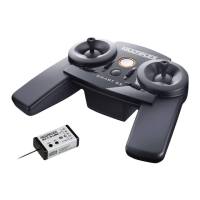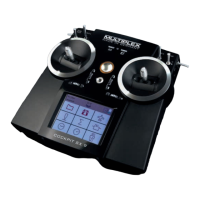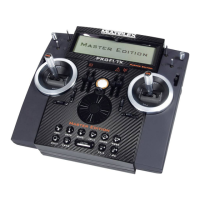Manual
9
It is essential to examine the airborne power sup-
ply and its wiring at regular intervals. This includes
the switch harness, and the external condition of
the battery.
Regular maintenance also covers the battery
gular maintenance also covers the battery (condi-
tioning by repeated charge / discharge cycles), and
regular checks of the voltage curve and capacity.
This requires the use of a battery charger and a
charge process which is suitable for the type of
battery in use.
Pre-flight checks:
Charge the transmitter, receiver and flight batteries
carefully, and ensure that they are in good condition
during pre-flight checks and between flights.
At the flying field your first job is to check with the
other modellers present whether your own channel /
transmitter frequency is free. If there is a flight di-
rector or site warden, be sure to register with that
person, and make sure you understand the type of
frequency control in use.
Only then switch ON!
Ignore this, and you risk a “channel clash” (two
transmitters on the same frequency)!
Carry out a range check with the transmitter aerial
fitted, but collapsed. ( 3.2.).
Ensure that the correct model memory is active.
Check the function and effect of all primary and
secondary control systems.
! If you discover anything doubtful: do not fly!
Locate the fault, eliminate it, then check again.
When operating the model:
If you have never flown a radio-controlled model, it
is really essential initially to ask an experienced
model pilot for help. A Trainer (buddy-box) system
is ideal for the first steps in learning to fly.
Models should only be operated at suitable sites.
Never fly or drive over or towards spectators.
Do not carry out any high-risk flying or driving ma-
noeuvres.
It is tempting to over-estimate your own ability and
skill. Don’t do it: keep within your limits.
If you detect any sign of a problem or interference,
land or cease operations immediately.
Caution: static electrical charges!
In extremely dry air (in mountainous terrain, in a
mountain bowl, close to weather fronts) static
charges tend to build up in the transmitter and / or
the pilot. The discharge takes the form of static
sparking, which can endanger the pilot, and cause
interference or damage to the transmitter.
Counter-measures:
Cease operations as quickly as possible, and walk
a little way down the mountain in order to find a
less exposed location.
Keep at least 2 m away from mobile phones!
We recommend that you stand at least 2 m away
from mobile telephones when operating your mo-
del, as the high output of these devices may cause
interference to your transmitter or RF module. In
general terms we recommend that you switch off
mobile phones and any other equipment which
could affect the concentration of pilots.
ESD notes for electronic sub-assemblies:
The sub-assemblies of radio control trans-
mitters (main circuit board, RF module,
Channel-Check module, Scanner module)
are fitted with electrostatically sensitive
components. These parts can be destroyed or their
useful life shortened if static discharges take place
(potential equalisation through electro-static dis-
charge) when the sub-assembly is touched.
The following protective measures are essential if you
have to handle electrostatically sensitive sub-
assemblies:
Before fitting or removing such assemblies, equal-
ise the potential difference between yourself and
your environment (e.g. by touching a heating radia-
tor).
If necessary, open the main device and touch it
over a large area, in order to equalise the potential
relative to the base unit.
Do not remove the sub-assembly from the conduc-
tive anti-static bag until you have equalised the po-
tential. Avoid touching electronic components or
solder pads directly. Hold the sub-assembly by the
edges of the circuit board only.
Once removed from the basic device, the sub-as-
sembly should only be stored in the conductive
anti-static bag in which it was delivered. Never al-
low the sub-assembly to make direct contact with a
conventional, non-ESD compatible container made
of foam, Styrofoam or other plastic.
3.2. Range checking
Regular range checks are very important - even when
using a 2.4 GHz system - in order to ensure reliable
operation of the radio control system, and to give you
a chance to detect sources of interference in good
time. This applies in particular:
Before the use of new or changed components, or
existing components in a new or modified arrange-
ment.
Before re-using radio control system components
which were previously involved in a crash or a hard
landing.
If you have encountered problems on a previous
flight.

